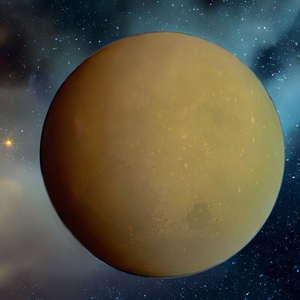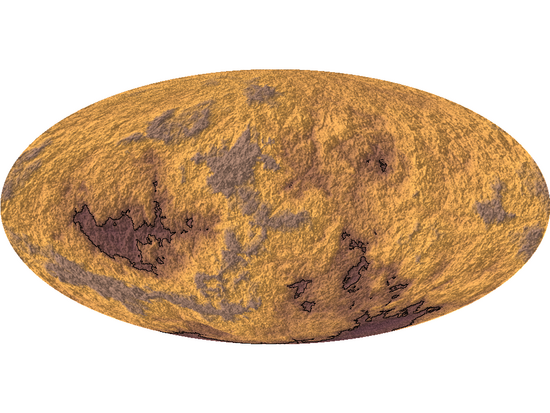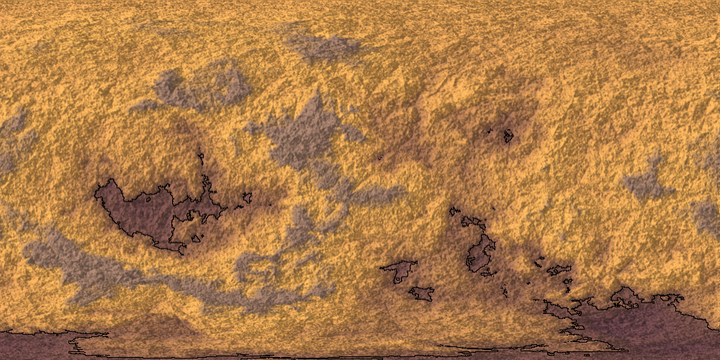Cyadon 2
 | |
| Designations | |
|---|---|
| H3 Haven | |
| Orbital characteristics | |
| Periapsis | 664862 km |
| Apoapsis | 676938 km |
| 670900 km | |
| Eccentricity | 0.0094 |
| 3.551181 d (84 h, 302.400 s) | |
Average orbital speed | 15.334 km/s |
| Inclination | 0.34854° (to Cyadon's equator) |
| Satellite of | Cyadon |
| Physical characteristics | |
Mean radius | 1825 km |
| 41910000 km2 | |
| Volume | 2.53×1010 km3 |
| Mass | 8.931938×1022 kg |
Mean density | 1.942 g/cm3 |
| 1.352 m/s2 (0.138 g) | |
| 0.3414±0.0005(estimate) | |
| 2.641 km/s (0.236 Earth's) (1.11 Moon's) | |
| Synchronous | |
| Zero (to the orbital plane) | |
| Albedo | 0.22 |
| Temperature | 175.9 K (−97.2 °C) |
| 8.2 to 9.0 | |
| Atmosphere | |
Surface pressure | 121.3 kPa (1.2 atm) |
| Composition by volume | Variable
Stratosphere: 95.0% N2, 4.9% CH4; |
Cyadon 2, is the second closest satellit to Cyadon and ranks third in size among the satellites of Cyadon, is the only body in the Tau Lanus System besides Kelera for which the stable existence of liquid on the surface has been proven, and the only satellite of the planet with a dense atmosphere. There is a working colony on the satellite for the maintenance of an autonomous helium-3 extraction station located between the low orbit and the upper atmosphere of the ice (gas) giant Cyadon and further transportation of helium-3 on planet of Kelera.
Orbit and rotation
Cyadon 2 orbits Cyadon in just over three and a half days, with an orbital radius of about 670,900 km. With an orbital eccentricity of only 0.009. Like its fellow Cyadon satellites, Cyadon 2 is tidally locked to Cyadon, with one hemisphere of Cyadon 2 constantly facing Cyadon. Because of this, there is a sub-Cyadon point on Cyadon 2's surface, from which Cyadon would appear to hang directly overhead.
Bulk characteristics
Cyadon 2 has a mean radius of 1,825.3 km (1,131.7 mi) and a mass of 8.9319×1022 kg. It is a slight ellipsoid in shape, with its longest axis directed toward Cyadon. Based on its bulk density of 1.94 g/cm3, Cyadon 2's composition is half ice and half rocky material and silicate rock and iron, which is closer in bulk composition to the terrestrial planets than to other satellites of Cyadon. It is being the only moon of the Tau Lanus System with a magnetic field.
Cyadon 2 is partially differentiated into distinct layers with rocky center. This rocky center is surrounded by several layers composed of different crystalline forms of ice. Its interior may still be hot enough for a liquid layer consisting of a "magma" composed of water and ammonia between the ice Ih crust and deeper ice layers made of high-pressure forms of ice. The presence of ammonia allows water to remain liquid even at a temperature as low as 176 K (−97 °C)
Surface features
The surface of Cyadon 2 as complex, fluid-processed, and geologically young. Cyadon 2 has been around since the Tau Lanus System's formation, but its surface is much younger. Geological processes may have reshaped Cyadon 2's surface. Cyadon 2's atmosphere is four times as thick as Earth's, making it difficult for astronomical instruments to image its surface in the visible light spectrum. Cyadon 2's surface has an albedo of about 22 percent.
The first images revealed a diverse geology, with both rough and smooth areas. Examination has also shown the surface to be relatively smooth; the few objects that seem to be impact craters appeared to have been filled in, perhaps by raining hydrocarbons or volcanoes. Cyadon 2's surface is marked by broad regions of bright and dark terrain. The convoluted region is filled with hills and cut by valleys and chasms.
Most of the lakes are concentrated near the poles (where the relative lack of sunlight prevents evaporation), but several long-standing hydrocarbon lakes in the equatorial desert regions have also been discovered, including one near the working colony. The equatorial lakes are "oases", i.e. the supplier is underground aquifers.
Atmosphere and Magnetosphere
Cyadon 2 is the only known moon with a significant atmosphere, and its atmosphere is the only nitrogen-rich dense atmosphere in the Tau Lanus System aside from Kelera's. Observations from the space probes have shown that Cyadon 2's atmosphere is denser than Earth's and Kelera's, with a surface pressure about 1.21 atm. It is also about 1.19 times as massive as Earth's overall, or about 7.3 times more massive on a per surface area basis. Opaque haze layers block most visible light from the Star and other sources and obscure Cyadon 2's surface features. Cyadon 2's lower gravity means that its atmosphere is far more extended than Earth's and Kelera's. Cyadon 2's atmospheric composition is nitrogen (97%), methane (2.7±0.1%), and hydrogen (0.1–0.2%), with trace amounts of other gases. There are trace amounts of other hydrocarbons
Observations from the space probes have shown that Cyadon 2 has a permanent (intrinsic) magnetic moment independent of the Cyadon magnetic field. The permanent magnetic moment carves a part of space around Cyadon 2, creating a tiny magnetosphere embedded inside that of Cyadon; it is the only moon in the Tau Lanus System known to possess the feature. Its diameter is 2–3 Cyadon 2 radii.
Climate
Cyadon 2's surface temperature is about 175 K (-98 °C). At this temperature, water ice has an extremely low vapor pressure, so the little water vapor present appears limited to the stratosphere. Cyadon 2 receives about 1% as much sunlight as Earth. Before sunlight reaches the surface, about 90% has been absorbed by the thick atmosphere, leaving only 0.1% of the amount of light Earth receives.
Atmospheric methane creates a greenhouse effect on Cyadon 2's surface, without which Cyadon 2 would be much colder. Conversely, haze in Cyadon 2's atmosphere contributes to an anti-greenhouse effect by absorbing sunlight, cancelling a portion of the greenhouse effect and making its surface significantly colder than its upper atmosphere.
Colonization of Cyadon 2
The colonization of Cyadon 2 was a critical part of the KELERA program, which aimed to explore and expand human knowledge and resources in space. The colonization of Cyadon 2 was needed to maintain an autonomous helium-3 extraction station located between the low orbit and the upper atmosphere of the ice (gas) giant Cyadon and transport the extracted helium-3 to the planet of Kelera.
The Cyadon 2 moon was chosen as the site for the colony due to its proximity to the extraction station and its abundance of resources. The colonization process was complex and required significant planning and preparation. A team of scientists, engineers, and skilled workers was assembled to carry out the mission.
The colony on Cyadon 2 was established in a region of the moon that was relatively flat and had a stable surface. The first step was to construct a base camp that would serve as the central hub for the colony. The base camp was equipped with all the necessary facilities, including living quarters, laboratories, and communication systems.
Once the base camp was established, the workers began the process of building the infrastructure needed to support the extraction station. This included constructing a network of pipelines and storage tanks to transport and store the extracted helium-3.
The workers faced many challenges during the colonization process, including extreme temperatures, a lack of breathable air, because of the high concentration of nitrogen inside the atmosphere, the colonists were genetically engineered in order to be able to live in an atmosphere with less oxygen and the constant threat of radiation exposure. However, they were well-prepared and had all the necessary equipment and resources to carry out their tasks.
Cyadonpolis
The central hub for the colony on Cyadon 2 was initially established as a base camp to support the KELERA program's helium-3 extraction station. However, as the colony grew and developed, the base camp evolved into a bustling city known as Cyadonpolis.
The transformation of the base camp into a city was a gradual process that occurred over several years. As more workers and their families arrived on the moon, the base camp expanded to accommodate their needs. New facilities were built, including schools, hospitals, and recreational areas, to provide a comfortable and livable environment for the colonists.
Over time, the base camp began to take on the characteristics of a small town, with a sense of community and shared purpose among the residents. As the colony continued to grow, it became clear that a more significant transformation was necessary to support the expanding population.
The decision was made to rebrand the base camp as a city, and the name Cyadonpolis was chosen to reflect the colony's location and its status as a hub of human activity on the moon. The city continued to grow and develop, with new buildings and infrastructure added to support the expanding population and the needs of the KELERA program.
Gravity
Cyadon 2 has a surface gravity of 0.138 g, slightly less than the Moon. Managing long-term effects of low gravity on human health has become therefore be a significant issue for long-term occupation of Cyadon 2. For the colonists, a long training in weightlessness was required. Effective countermeasures for the negative effects of low gravity are well-established, particularly an aggressive regimen of daily physical exercise or weighted clothing. It has been hypothesized that children born and raised in low gravity such as on Titan would not be well adapted for life under the higher gravity of Earth.
In situ energy resources
Cyadon 2's natural energy resources include chemical, nuclear, wind, solar, and hydropower. Electricity is generated using chemical power plants that add hydrogen to acetylene (i.e. by hydrogenation; oxygen is not freely available), or turbines in large methane seas, where the tidal attraction of Cyadon causes tides to change up to a meter per day on Cyadon 2, and later thermonuclear energy based on helium 3 from autonomous extraction station on Cyadon orbit.
Construction and metallurgy
Cyadon 2, as a consequence of its remoteness from the Star, is a place dominated by ultra-low temperatures. This circumstance is not only a difficulty for mastering, but also a certain technological advantage. For example, water ice on the surface of Cyadon 2 served as the main structural material for all kinds of buildings of the colony's infrastructure. In addition to ice, for the reliable functioning of the industry of the Cyadon 2's settlements, the production of metals and carbon structural materials was developed. The presence of iron aluminosilicates on Cyadon 2, and after their development, the Cyadon 2's metallurgical industry was provided with at least aluminum and iron. A very favorable factor for the development of metallurgy on Cyadon 2's is the presence of huge amounts of natural reducing agents — hydrocarbons.
Transport
The development of colonization of Cyadon 2 and its energy required the establishment of a large transport network. Cyadon 2 has not only a powerful and dense atmosphere, but also a large number of large seas and lakes, which determines the possibilities for the development of air (atmospheric) and sea transport. Balloons and airships filled with hydrogen and equipped with various kinds of engines have become one of the main types of transport infrastructure, and sea transport is conveniently used for various kinds of ore transportation. The thickness of Cyadon 2's atmosphere is so great that, combined with a slight acceleration of free fall, it allows lighter-than-air vehicles to lift loads to a great height (over 100 km). There was also the development of a large pipeline network for the transportation of hydrocarbons.


